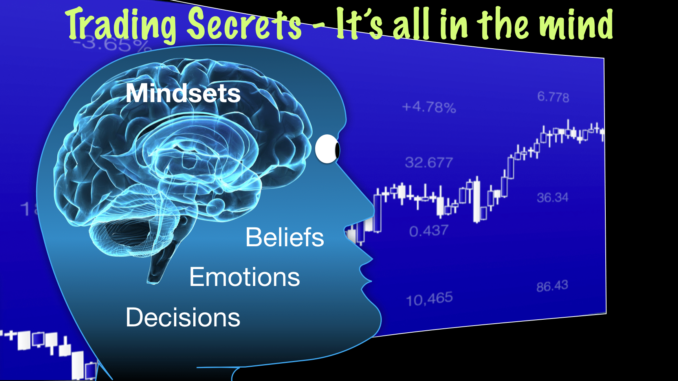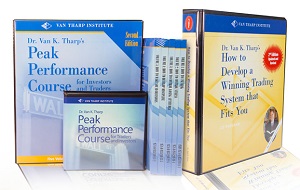
Crafting the Trader’s Mind and Developing the Trader’s Toolkit By Van Tharp Trading Institute
I was reviewing the “Future of Jobs Report 2020” by the World Economic Forum, which lays out the top 10 cognitive skills needed to survive and thrive in the world, as an individual and as an organization.
It was as if I had been hit in the face with a wet fish. You know what that feels like already, even if it hasn’t happened to you personally.
These top 10 cognitive skills describe what I have been thinking of as “The Trader’s Mind”.
I have been reviewing our many lessons learned over the past two years of Covid and have seen how our adaptive learning approach to day trading, swing trading, and position trading―blended by “Hybrid Trading”―have been an essential ingredient to our success.
I have been thinking about how to render the essential elements of effective thinking and action-taking together in this concept of The Trader’s Mind, and further, how to train and educate in this mindset for bullet-proof performance under stress.
When I compared my list to the skills identified by the WEF, I knew we were close to getting it right.
Necessary Cognitive Skills
I propose that the WEF list is a necessary but not sufficient list of ingredients needed for trading success. We need all of them, but there is more to cooking than stacking up boxes of ingredients.
Here is what the WEF lists as necessary cognitive skills for 2025 and beyond.
Analytical thinking and innovation. Both divergent and convergent thinking are needed.
Active learning and learning strategies. The world changes, so should you, in a sensible way.
Complex problem-solving. The problems are complex but solving them can and should be simple.
Critical thinking and analysis. That’s not the endpoint! The work has just begun!
Creativity, originality, and initiative. It turns out you can learn to be more creative, and quickly.
Leadership and social influence. Powerful, trusted tribes of mutual support, led by vision.
Technology use, monitoring, and control. Respect the game and respect the power tools.
Technology design and programming. Systems thinking and process management are an edge.
Resilience, stress tolerance, and flexibility. It’s a marathon, not a sprint. Train accordingly.
Reasoning, problem-solving, and ideation. Iterate towards success with continuous improvement.
A great list, but it leaves the hard work to us―how to put these into action to develop a systematic, effective, rapid learning process with feedback that is grounded in reality checks from a changing world that is not shy about letting you know how you are doing.
Taking our lead from thousands of years of craft knowledge in how to create beautiful, enduring functional, purposeful works of art like furniture, we are developing a community of practice. This community is dedicated to individual and group learning, based on the True Storytelling Process principles of Safety, Trust, Truth, and Opportunity.
Safety: The first and most important condition. Manage risk, have a safe place to learn forward, protect your boundaries, respect your limits, know yourself and your enduring risk appetite.
Trust: Surround yourself with trustworthy learning partners, dedicated to mutual striving, surviving, thriving.
Truth: Base your work, insights, and knowledge sharing on evidence and best practices in generating useful knowledge, with proven tools.
Opportunity: When you start with the first three ingredients, add creativity and critical-thinking points of view. You cannot help but generate plenty of opportunities to investigate. There are so many potentially good ideas generated that you have the problem that everyone wishes they had―how to choose.
Developing Transformational Learning
Here are the steps that have emerged for us through two years of daily hard work in the fire of Covid-driven innovation.
Steps in developing transformational learning:
Mission: Be aligned with your purpose.
Future self: Visualize your future self successfully performing, in detail.
Bird’s eye view: See the forest AND the trees, view it as a process, a hero’s journey.
Constant wins: Build on a foundation of daily successes. Each step is a victory.
Peak emotional experience: Recognize the growth and feel the connection to your final success.
Normalizing challenges: Get used to the work and the striving. Embrace the play.
Feedback loops: Evidence-based learning from your ASSESSMENTS.
Community: Build a safety-net network of trusted, truthful supporters.
Unstoppable momentum: Crush it.
Mission accomplished: Know your measures of success and cross the finish line.
Here is a simplified, “Caveman version” that I like:
OK, fine (commit to the change, now get on with it.
Make a list.
Pick one.
Go!
Learn!
Keep going!
You will know when to stop (never!… be a flywheel)
What Learning Looks Like
So, now that we are ready to work on a steady program of continuous learning, what does that look like on any given day?
What does an experientially-based, community-of-practice, engaged-learning look like in a safe, trusted, and truthful space?
It looks like taking world-class insights about essential cognitive and emotional skills, like Creativity (#5 on the WEF list) and creating an enduring edge for all our trading efforts going forward.
Here is a sample “Trader’s Exercise.” This is number 09, specifically, from our 30-lesson course on Creativity, entitled “Creativity 202: The Fletcher Treatment for Traders”.
We’ve partnered with Professor Angus Fletcher of The Ohio State University (a world authority on “story science” and the use of literature to quickly increase our creativity and generate other therapeutic effects as well.
Trader Exercises 09: Creating Your Flashcard Deck
What are your standard plays?
Make a hand-drawn flashcard for your favorite patterns, with all the rules and planning factors you need to explain to a novice trader.
Now compare your flashcard to the standard trade framing questions. Are they all accounted for in your flashcard?
What are you missing? Is the missing piece a frequent problem area for you that keeps you unprepared too frequently?
Take your second favorite pattern and do the same.
Was it easier the second time?
Did you learn something the second time that you want to add to the first flashcard?
Make a checklist of your “recipe” for making a flashcard. Include a standard way of laying out the slide so that you have a template for flashcards.
Create a deck of flashcards for patterns, indicators, and exit management.
What other sections do you need?
Consider System, Self, Market vs Strategies, Systems, and Tips.
Do you have “Recipes” (processes) or just pictures?
What other flashcards do you need?
Are all your flashcards operating in the same time frame?
Which patterns are fractal? Which ones might be?
How does the Gap affect the patterns when considering overnight risk?
Van Tharp Trading Institute Trading Education Courses

